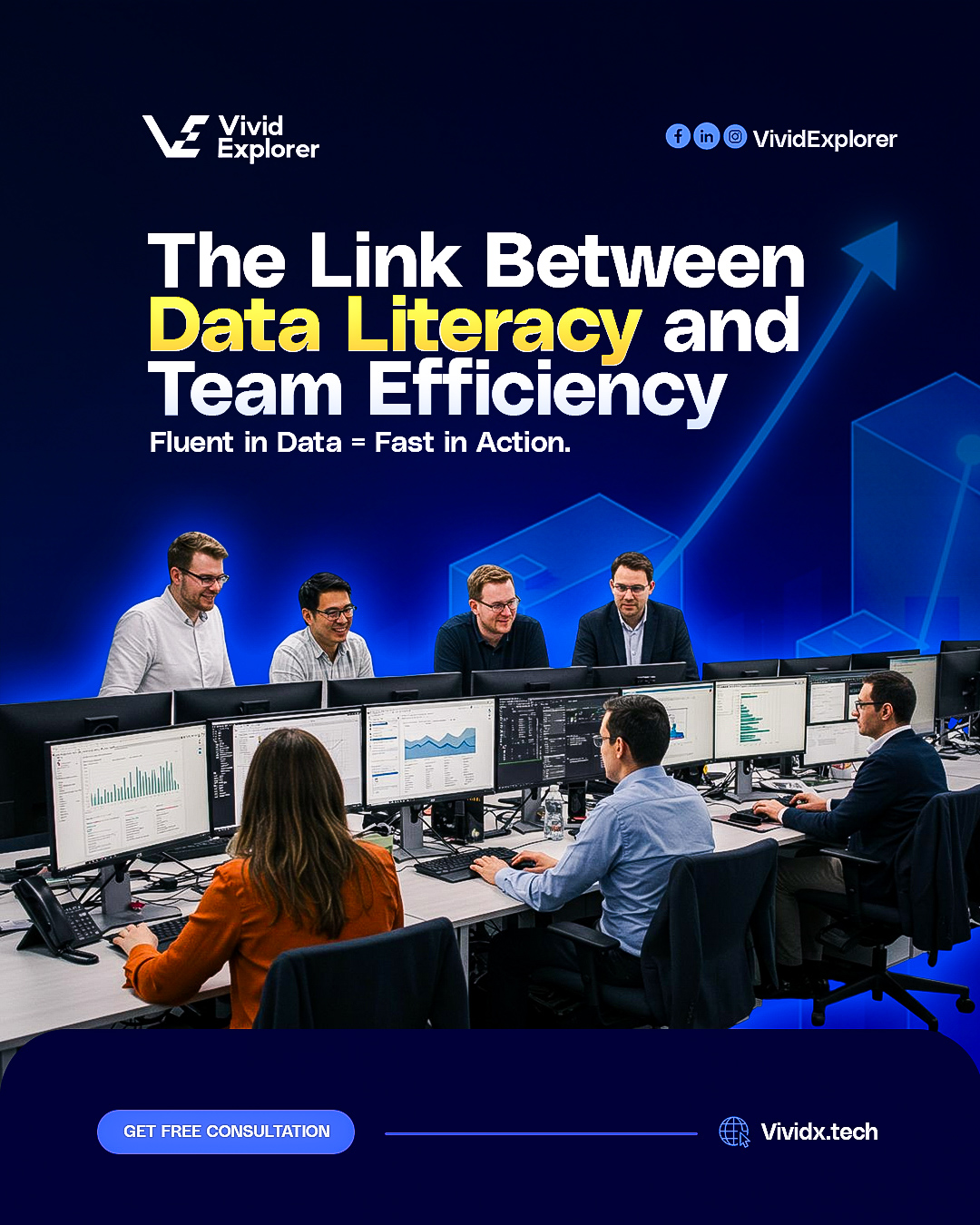The Link Between Data Literacy and Team Efficiency: Fluent in Data = Fast in Action
Efficiency is not about doing more in less time; it’s about making the right moves with clarity and confidence. Teams fluent in data eliminate guesswork, accelerate collaboration, and act with precision. Data literacy is no longer optional — it is the foundation that separates agile, high-performing organizations from those trapped in slow, opinion-driven cycles.
“Fluent in Data = Fast in Action. When teams understand data, efficiency stops being a goal and becomes a natural outcome.”
Organizations often invest heavily in advanced tools, platforms, and analytics systems. Yet, without the ability to understand, interpret, and apply data, even the most sophisticated technology falls short. This is where data literacy becomes the cornerstone of team efficiency.
Data literacy is more than just technical skill; it is the language of modern business. When teams are fluent in data, they can move faster, make smarter decisions, and eliminate the delays caused by confusion, misinterpretation, and endless back-and-forth discussions.
Why Data Literacy Matters
Efficiency is built on clarity, and clarity comes from shared understanding. Without data literacy:
- Decisions slow down → Teams wait for “experts” to interpret insights.
- Errors multiply → Misunderstood metrics lead to poor choices.
- Innovation stalls → Lack of confidence in data prevents experimentation.
- Dependency grows → Teams rely too heavily on analysts or external consultants.
On the other hand, when employees across functions understand data, efficiency accelerates. Meetings are shorter, strategies are sharper, and actions are aligned.
The Efficiency Advantage of Data-Literate Teams
Teams fluent in data operate with a different rhythm:
- Faster Decision Cycles → Everyone speaks the same “data language,” reducing translation delays.
- Cross-Functional Collaboration → Shared understanding eliminates silos between departments.
- Proactive Problem-Solving → Teams identify issues before they escalate.
- Resource Optimization → Efforts are directed where evidence shows the highest impact.
- Culture of Confidence → Employees act decisively because they trust the insights guiding them.
Data literacy turns analytics from a specialized function into an everyday competency.
Data Literacy in Practice: Sector Insights
- Retail → Sales teams fluent in metrics adjust campaigns in real time instead of waiting for weekly reports.
- Healthcare → Nurses and doctors interpreting patient data directly improve outcomes without bottlenecks.
- Finance → Advisors use dashboards confidently, accelerating client decisions and trust.
- Manufacturing → Line managers fluent in production metrics reduce downtime and improve output.
Across industries, the equation holds true: fluent in data = fast in action.
Building a Data-Literate Workforce
Creating efficiency through data literacy is not automatic — it requires deliberate investment. Key steps include:
- Executive Sponsorship → Leaders must prioritize and champion data education.
- Practical Training Programs → Focus on real-world applications, not abstract concepts.
- Accessible Tools → Provide dashboards and platforms designed for clarity, not complexity.
- Cultural Embedding → Encourage every department to treat data as part of daily decision-making.
- Continuous Learning → Keep skills sharp as data sources, tools, and business needs evolve.
The goal is not to turn everyone into a data scientist, but to create teams fluent enough to act quickly and confidently.
Fluent in Data = Fast in Action
Efficiency doesn’t come from speed alone; it comes from making the right moves at the right time. Data literacy ensures that teams not only act quickly but act intelligently.
At Vivid Explorer in VividX, we help organizations embed data literacy as a cultural advantage — transforming teams into agile, efficient units capable of making better decisions, faster.
Similar publication
Accurate data isn’t optional, it’s the foundation for every decision, strategy, and action. When teams trust their numbers, decisions happen faster, strategies gain clarity, and opportunities are captured before they pass. At Vividx, we design systems that turn insight into confidence and confidence into measurable growth.
Read MoreData alone doesn’t transform a business. Real impact comes when insights are acted upon. Organizations that move from insight to execution turn analytics into growth, efficiency, and measurable results. At Vividx, we design systems that ensure insights don’t sit idle, they drive decisions, action, and meaningful outcomes.
Read MoreLeaders who understand their data don’t wait for reports or approvals. They interpret insights, act confidently, and make decisions in real time. Insight without speed leaves opportunities on the table. Speed without insight leads to mistakes. Data-literate leaders combine both, turning information into action and strategy into results.
Read MoreAutomation was never meant to replace people. It was meant to remove the weight that slows them down. The most effective systems think for you by clearing noise, reducing delays, and preparing the insights leaders need before decisions are made. When automation is aligned with strategy and designed around human judgment, it doesn’t overshadow talent, it amplifies it. Organisations don’t lose the human element. They gain a stronger, sharper, more focused version of it.
Read More